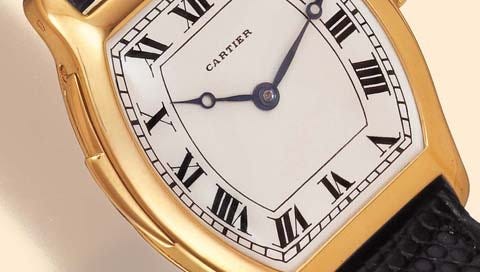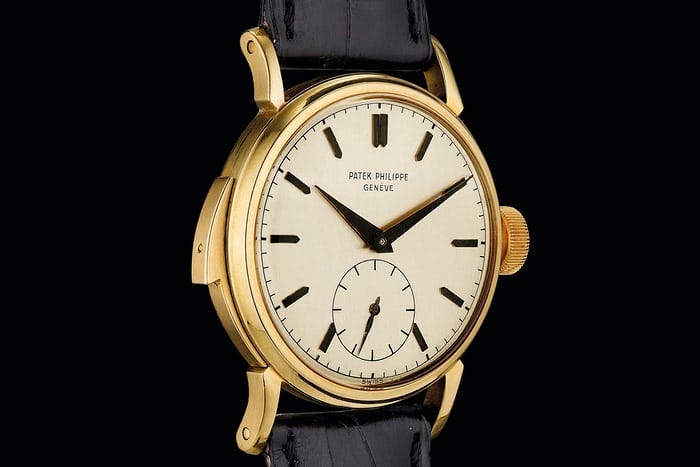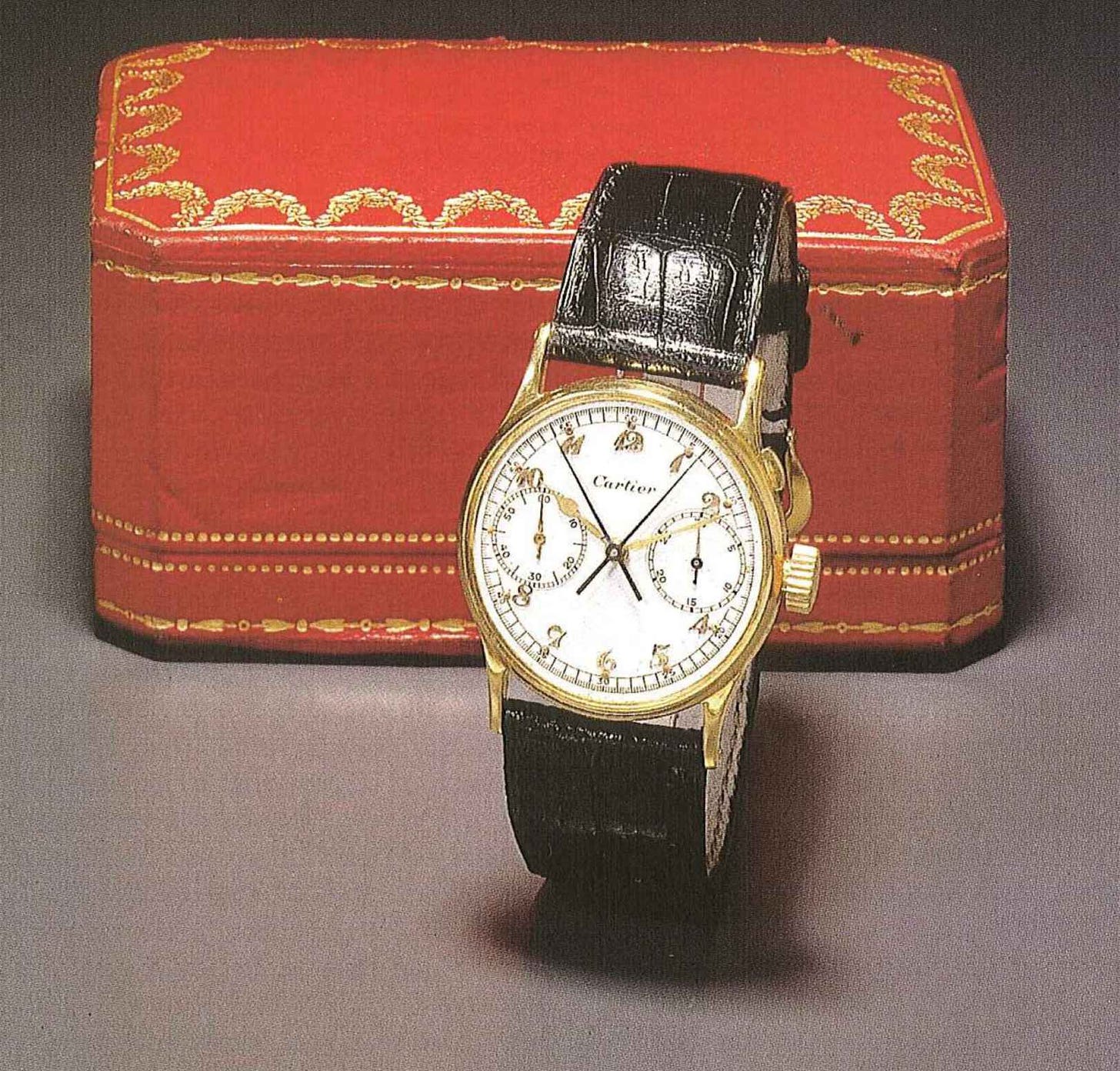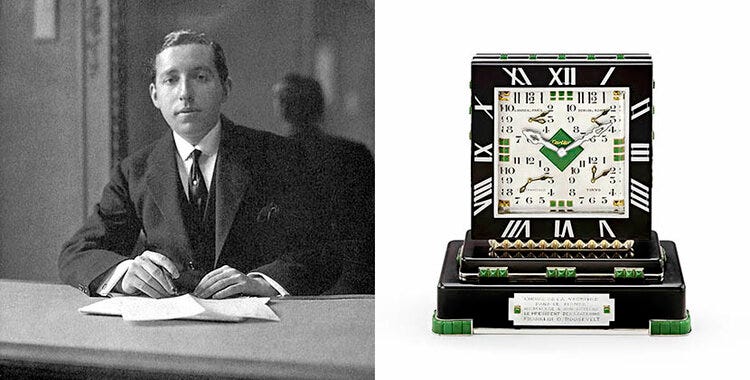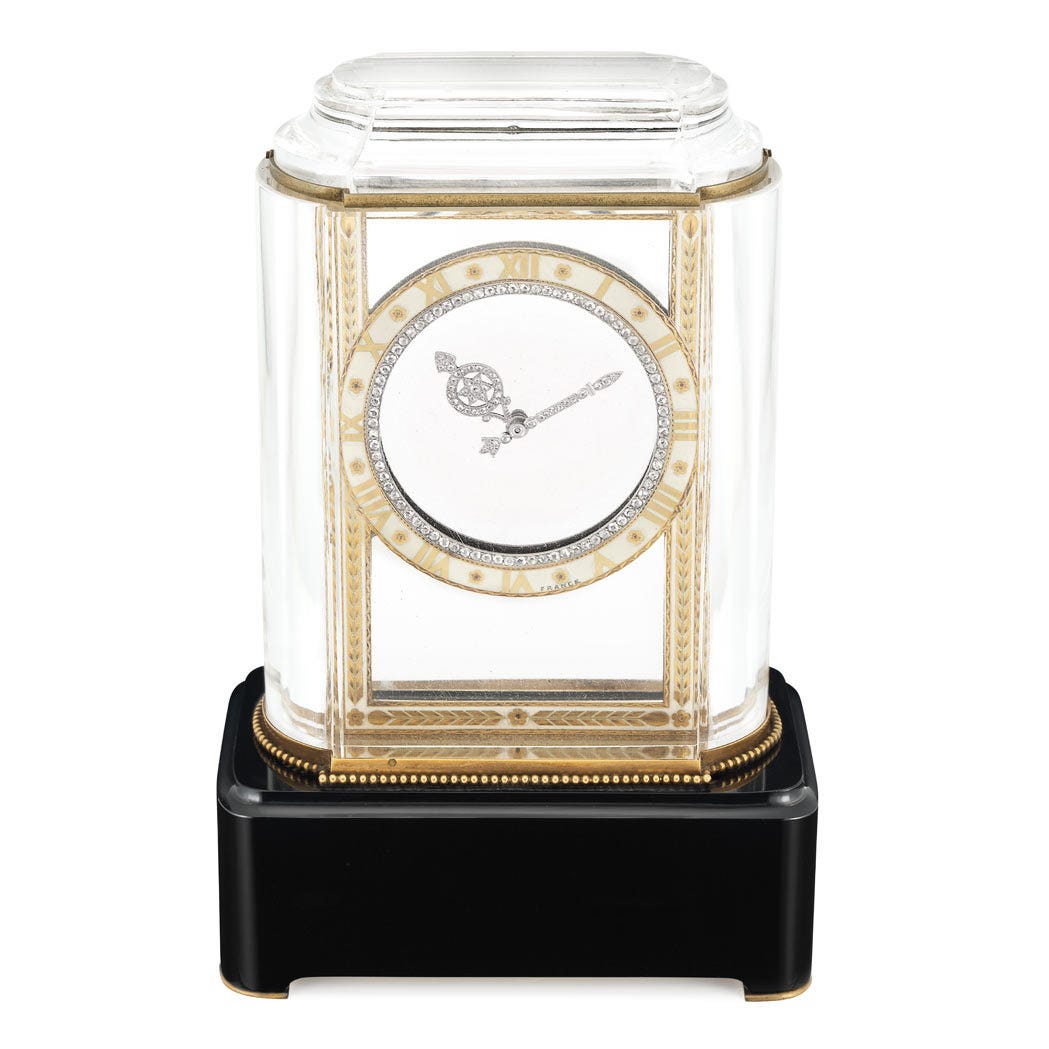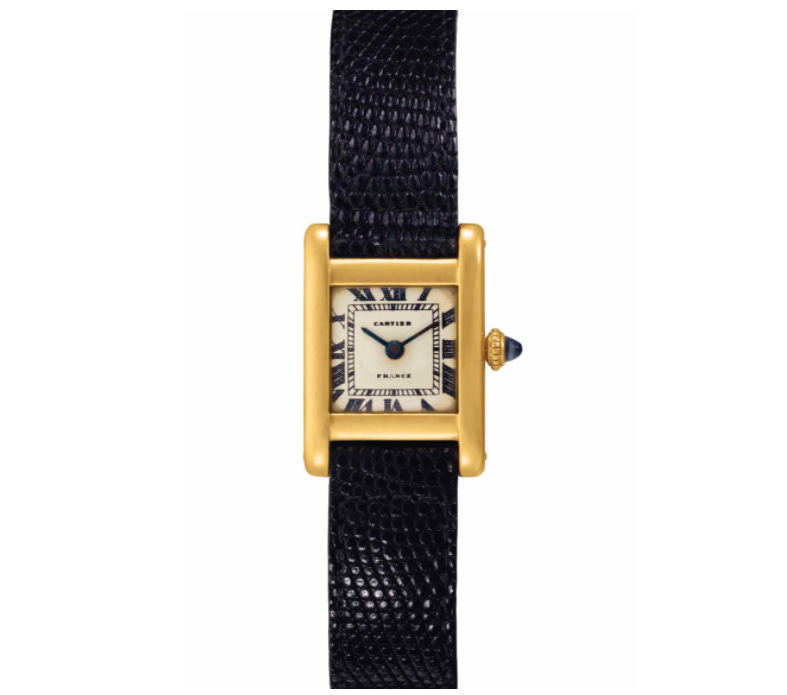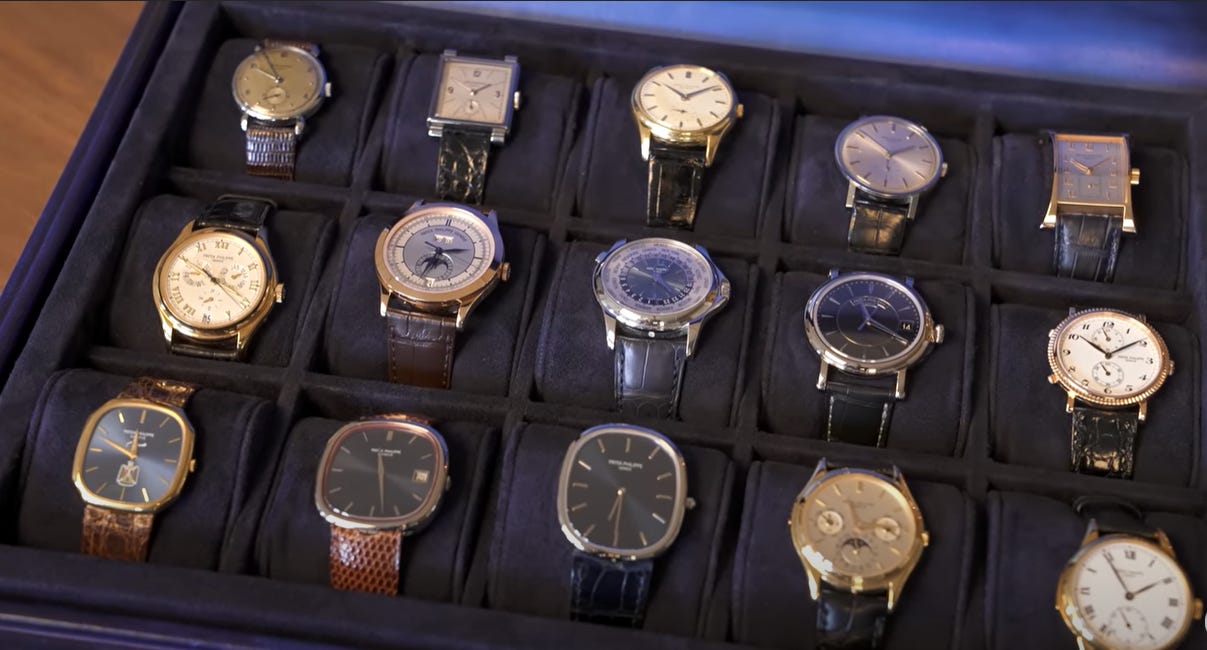5 of the most expensive vintage Cartiers ever sold at auction
And a briefcase full of $700k worth of Patek Philippe
At the last round of Geneva auctions back in May, Phillips sold a Cartier Pebble for CHF400k. A few weeks later, Bonham’s sold one for slightly less ($311k). It prompted me to ask the question: Is now the best time to buy a Cartier Pebble, or the worst? (Answer: if you can swing buying a Pebble, you’re probably already having a pretty good time.) There are thought to be six Large Cartier Pebbles, so with one-third of them popping up in one month, it felt natural to wonder.
After the Phillips result, some began to blindly write that it was the “highest result ever achieved for a vintage Cartier.” Like a sheep being led to slaughter, I parroted these words. “They’re the experts,” I thought.1
Wrong!
A few weeks of digging later, I’ve arrived at this list of some of the most expensive vintage Cartier watches ever sold at auction. Are they the most expensive? Idk, I’m probably missing some, so I fear making such grandiose statements. I’ve been sent a few watches to help compile this list, and I’m sure I’ll be sent a couple more after this.
As for what this list is not: I eschewed double-stamped watches, so you can keep your record-breaking Cartier-stamped Patek reference 2499s and so on. Cartier only on these dials, baby.2
Tortue Minute Repeater
Sold by Antiquorum in 2002 for CHF 993k.
According to the lot description when Antiquorum sold this Tortue Minute Repeater in 2002, this was the “only minute repeating watch known to have been made by Cartier during the Art Deco era” (more on that claim in a minute). The yellow gold watch was entered into Cartier’s registers in 1929 and eventually sold in 1931. It features Breguet blue steel hands and a movement signed by European Watch & Clock Co., a common supplier of Cartier’s movements during the era. The slide on the left side of the case triggers the gongs which chime the time.
According to Antiquorum, this watch has also been published in books, and previously appeared in an Antiquorum catalog from 1982. As far as I can tell, this Tortue Minute Repeater holds the record for the highest result ever achieved by a vintage Cartier at auction.
Second Tortue Minute Repeater
Sold by Antiquorum in 2004 for $640.5k.
Two years after selling the above Minute Repeater for nearly one million Swiss francs, Antiquorum sold this one for $640.5k. According to the auction house, this one dates to 1928, a year prior to the previously sold example — making it the first known Cartier Minute Repeater. Like the first example, the caliber in this one was also manufactured by European Watch & Clock Co. It is interesting to point out that two years after the auction house claimed it’d found the “only Cartier minute repeater from the Art Deco era,” (and so confirmed by the Cartier archives), it managed to find another one. It shows how knowledge and scholarship continues to evolve over the years.
Engravings always provide another avenue of discovery, and this example is carved “X. M. Audibert, Union Club, New York City” on the caseback. A few minutes of googling reveal Mr. Audibert purchased a house at 9 E 79th St in New York in 1939 (in fact, he may have been a bit of a real estate mogul). It looks like that building, originally built in 1928, is still standing just across the street from The Met (the penthouse floors just sold for $7m). I don’t know, it’s pretty cool that this Mr. Audibert is long gone, but his condo is still standing and his minute repeater is still striking.
Antiquorum offered this watch at auction again in 2007, but that time around the lot is listed as unsold.
Patek Philippe Minute Repeater reference 2419
Sold by Phillips in 2016 HKD 9.8m
Sold by Antiquorum in 2011 for $710,500
Okay, I know I said “no Pateks!” in the intro, but hey, I made the rules so let’s break the rules. This watch is too good not to include. While we’ve seen a couple Art Deco-era minute repeaters now, this Patek reference 2419 comes from a generation later, having been made in 1946 and finally retailed by Cartier in April of 1950.
The original Antiquorum lot description provides interesting details about the sale of this piece: Cartier hosted a special event for Patek Philippe in New York in April of 1949 to showcase their important watches and complications. Assuming this minute repeating caliber had already been manufactured at this point (but remained uncased), one could assume the original owner met with Patek Philippe after this showcase to discuss creating a minute repeater, eventually having it delivered exactly one year later in 1950.
As the original Antiquorum description details, the minute repeater was purchased by a New York businessman who was already in his more advanced years when he acquired the watch (we’re all just working towards Patek minute repeaters, aren’t we?). That’s why the dial appears so simple, with an oversized subsidiary dial, a unique, large crown (for easier winding), and an oversized repeater slide. The hands and hour markers are also painted black for maximum contrast and visibility against the dial.
This watch came up for auction again at Phillips in 2016, when it was offered alongside another Patek minute repeater (that one Tiffany-stamped), which was ordered by the same client to be worn while his first minute repeater was away at service. Take a look at the two watches side-by-side and you’ll immediately notice their aesthetic similarities.
Thanks to Charles Tearle for bringing this watch to my attention. He originally found the watch while working for Antiquorum in 2011. We also have him to thank for the detailed lot description and story of the original owner!
Cartier Split-Seconds Chronograph by Patek Philippe
Sold by Antiquorum in 1996 for CHF 333.5k
When I endeavored to put this list together, my first stop was the 1996 “Magical Art of Cartier” auction by Antiquorum, a sale to celebrate the occasion of Cartier’s 150th anniversary. It’s 624 lots of straight heat from Cartier — watches, jewelry, and everything in between. Only a fool would reduce the beautiful objects in that sale to feature only the highest monetary result, but I’ve never claimed to be anything other than such. Everyone should give the full catalog a *magical* scroll.
This split-seconds (rattrapante) chronograph is signed Cartier on the dial and features beautiful gold Breguet numerals to match the yellow gold case. It’s powered by a Patek Philippe caliber — while the watch measures just 33mm, this is no doubt the biggest, baddest watch I’ve ever seen. In fact, its result in the Magical Art of Cartier sale slightly topped that of a Cartier double-stamped Patek reference 1436, which sold for CHF 278k (which is not to say these can’t achieve superior results: here’s a Cartier-stamped ref. 1436 that sold in 1989 (!) for CHF 490k).
FDR Victory Clock
Okay, these clocks might be considered more of a detour from your regularly-scheduled programming, but Cartier clocks are at least worth mentioning. The most important Cartier clock ever is undoubtedly this Cartier Victory Clock, gifted to FDR by Pierre Cartier for Christmas of 1943, when the world was still in the midst of World War II. Sotheby’s auctioned it off in 2007 for $1.6m. See our article 3 Timepieces Gifted to FDR for more on this significant Cartier Victory Clock.
Cartier Mystery Clock
Sold by Doyle in 2013 for $515k.
Cartier clock collecting is a whole new boss level that we’re not going to get into, other than to mention that they made these totally ridiculous “mystery clocks” in the 1920s, so-called because the rack-and-pinion system is hidden to make it seem as though the hour and minute hands are floating in thin air. These things regularly achieve big numbers, but one of the most impressive is this particular clock which came from the estate of Counselo Vanderbilt Earl (like the great-great-great granddaughter of Cornelius Vanderbilt, I'm not really sure).
Doyle Auction sold this rock crystal, gold, black onyx, and enamel clock for $515k back in 2013. It was a record price at the time, and while other Cartier mystery clocks have certainly achieved higher prices since, this one remains interesting because of its historical provenance.
Cartier Tank Owned by Jacqueline Kennedy Onassis
Sold by Christie’s in 2017 for $379.5k
You’ll notice the previous Cartiers all have something in common: namely, they’re complicated. Uber-complicated, really. This one’s got something else to set it apart — it was owned by Jacqueline Kennedy Onassis. Christie’s sold it back in 2017 for $379.5k, along with a painting by Mrs. Kennedy Onassis herself.
As was later reported, it was bought by Kim Kardashian, who dropped more than three times the high estimate on it. Honestly though, with Cartier Pebbles selling for the same price nowadays, it may prove to have been not such an outlandish purchase after all.
A Sisyphean Pebble
For decades, it was a prerequisite for a record-breaking Cartier to be a special, complicated timepiece, or perhaps a decorative clock (that, or owned by one of the most famous people of the 20th century).
While not a record like some claimed, the Cartier Pebble results from Phillips and Bonhams do represent a shift in the market. Now, simple, time-only watches are achieving eye-popping results too.
With the current strength of the Cartier market, it’s a trend that shows no sign of letting up anytime soon. We’ve been tracking the results of the 1991 Paris Edition Crash for the past couple years, but imagine if an original London Crash comes up for auction in the next couple years — there’s no telling what it could go for.
👉 For more in-depth articles exploring vintage Cartier, auctions, and more, subscribe to our exclusive (free!) weekly newsletter. The only way to get all our content:
Recommended: Patek Philippe Grails with Collectability
By: Charlie Dunne
Over the past two weeks, Chrono24 has released 54 minutes worth of Patek Philippe content featuring none other than John Reardon of Collectability. Reardon is recognized as one of the world’s leading experts on the Genevan watchmaker. In December of 2019, he started the next chapter in his saga founding Collectability, a platform centered around Patek Philippe. The first Chrono24 video came out of left field when I spotted the title “Inside an Impressive Watch Collection and Career | Part 1” on my YouTube homepage.
The video starts off with Reardon flexing an electric blue leather briefcase that quite frankly appeared to be an accessory suited for a member of Pimp Legion of Doom.
The two discuss how Reardon caught the watch bug in his teenage years from his brother-in-law, whom he described as being “the nerdiest guy on earth” due to his obsession with American-made pocket watches. Something tells me his brother-in-law got the last laugh all these years later. Hendricks and Reardon would go on to cover a variety of subjects from his experience in the auction world, collector archetypes, his own personal collecting, and more.
Part 2, “Inside a $700,000 Patek Philippe Watch Collection,” was released soon after:
For a few of Charlie’s favorite watches from Reardon’s collection, head to the full article.
As a side note, much of the “conventional wisdom” in watches is really just hearsay, a long game of telephone played across generations and continents. Trust, but verify, as a certain actor-slash-president was fond of saying.
Though it does raise an interesting question, I suppose. As you’ll see, most of these vintage Cartiers feature outsourced movements from manufacturers like European Watch or Patek. So when is a “Cartier watch” a Cartier watch? For more on that philosophical inquiry, I’ll redirect you to your freshmen philosophy lecture on the Ship of Theseus.


